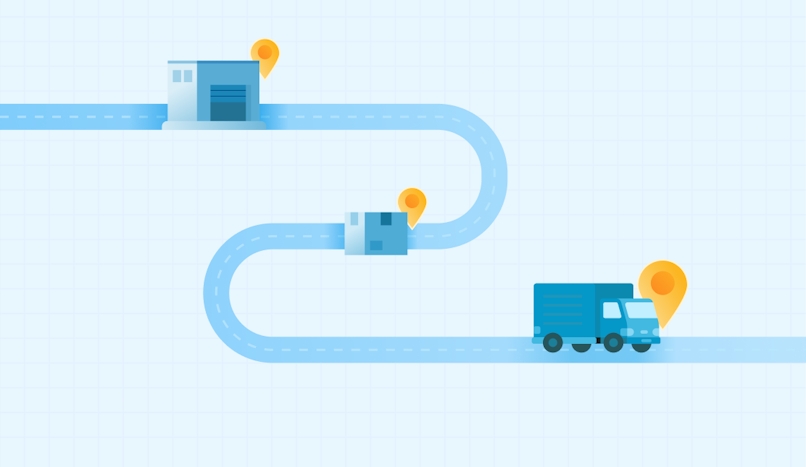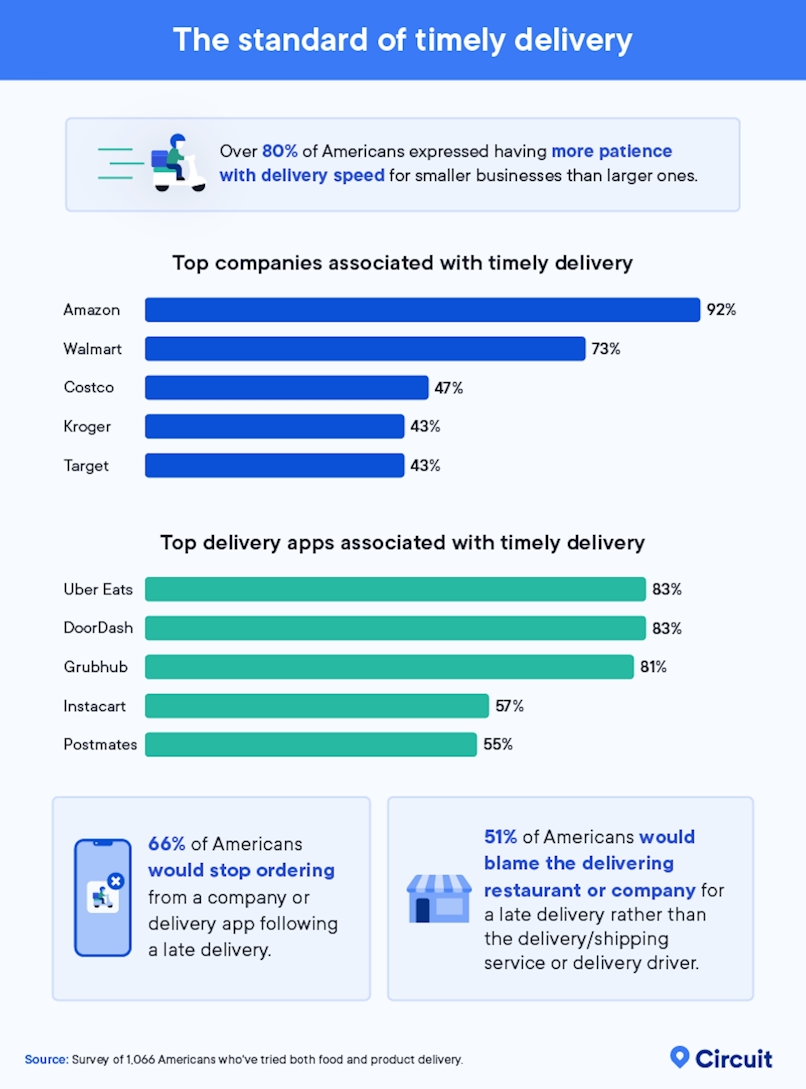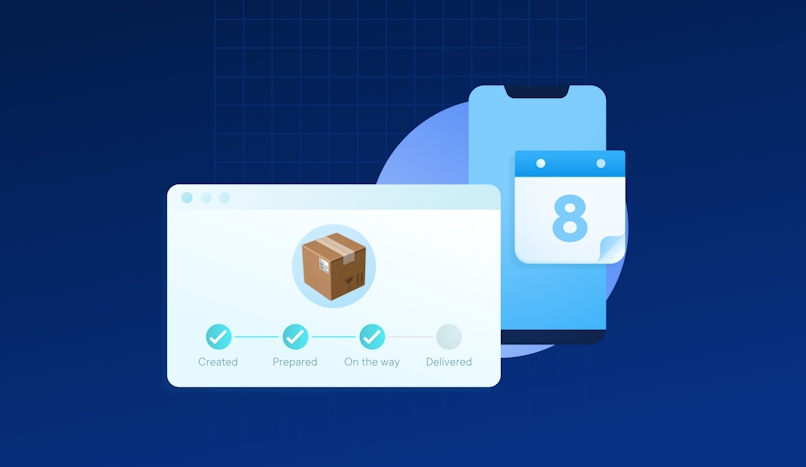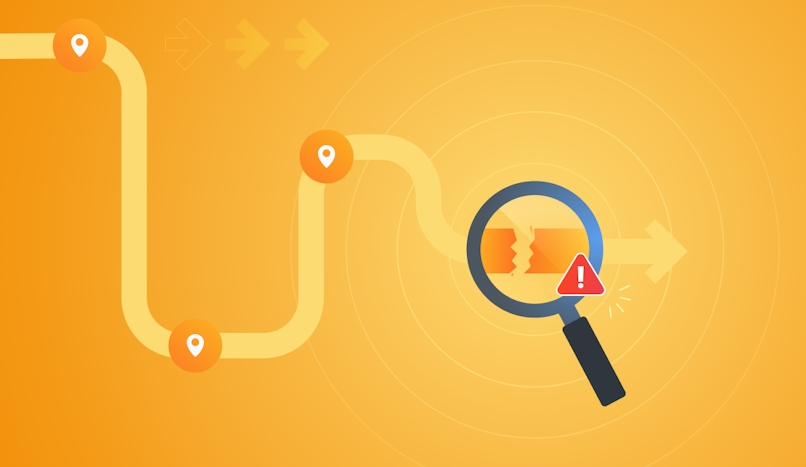7 Benefits of Real-Time Tracking in Logistics
Real-time tracking is a game changer in logistics. Discover how it can help you optimize your supply chain and improve customer satisfaction.

Not using Circuit for Teams? If you want to quickly and easily manage your team of drivers and product deliveries, start your free trial today.
Key takeaways:
- Optimize and streamline your delivery process to drive efficiently.
- Minimize failed deliveries and reduce delivery costs.
- Provide excellent customer service and increase repeat purchases.
Let’s say you’re the proud owner of a chocolate brand. Your business is growing and you want to make sure your operations are efficient to maximize productivity and customer satisfaction.
The journey of your products from the factory to the customer’s doorstep is a critical part of your brand’s success.
Cocoa beans are probably harvested in West Africa and transported overseas to the processing plant, where they’re cleaned, roasted, and ground into cocoa powder.
Once ready, the chocolate bars ship to a central warehouse before being transported to a retailer or distributor.
Finally, it’s time for the big moment — chocolate bars are transported to the local store or even directly to your customers’ doorsteps.
This complex logistics process allows your beloved customers to get their chocolate fix in the most efficient way possible.
And the same applies to any other product in the market.
But with so many moving parts, how can you be sure your product is on its way and will arrive on time?
The answer lies in real-time tracking, the superhero of the logistics world.
With real-time tracking, you can keep an eye on your products at each step — from their journey across the ocean to their arrival at the local store.
What does this mean? Efficient delivery, happier customers, less inventory waste, and more profit.
In this article, I’ll explain everything you must know about real-time tracking and its benefits.
What is real-time tracking?
Real-time tracking is a technology that uses GPS and logistics databases to track products, people, packages, or vehicles in real time.
We all know that getting products delivered on time is critical for the reputation and success of your business.
We don’t need numbers to tell us that customers want their orders delivered fast and reliably. I mean, who likes waiting forever for their package to arrive?
But if you need some convincing, let’s take a find at the stats:
- According to a recent Statista survey, almost 50 percent of US shoppers were willing to wait only three to five days for direct-to-consumer (D2C) delivery.
- Sixty-six percent of Americans would actually stop ordering from a company following a late delivery (especially baby boomers).
- If they don’t get the item they bought within two days of the promised date, 69 percent of respondents said they are “much less likely” or “less likely” to shop with that retailer in the future.
Now that you know that on-time delivery is vital for business success, the next question is: How can you deliver on your promise of speed?
Fortunately, real-time tracking offers a solution to take the guesswork out of your logistics.
To drill a little deeper, real-time tracking gives up-to-date information about the current location, movement, and status of your package
But apart from that, real-time tracking can keep you in the loop about all the details.
Curious to learn if your drivers are behind or ahead of schedule? Done.
Want to manage multiple routes to save time? Check.
Worried about potential delays? Real-time tracking has got you covered.
Want to know the temperature and humidity levels of your package during its journey? Real-time tracking might tell you that too.
Real-time tracking might seem like magic, but it’s a real technology available to help you streamline your logistics and improve customer satisfaction.
Let’s take a more in-depth find at how you can use real-time tracking to up your logistics game.
The benefits of real-time tracking in logistics
Gone are the days of calling your drivers for updates or relying on guesswork to predict when they’ll deliver customers’ packages.
With real-time tracking, you always know where customers’ deliveries are and if they’ve arrived on time — giving you full control over your delivery operations.
But wait, there’s more: Real-time tracking can help reduce costs, identify bottlenecks, and improve customer satisfaction.
Let’s take a closer find at how real-time tracking can benefit your business.
Real-time tracking benefits:
- Improved visibility
- Enhanced customer service
- Better inventory management
- Improved safety and security
- Faster identification of delays
- Competitive advantage in the industry
- Increased efficiency
Improved visibility
If you’re managing multiple drivers, juggling multiple routes, deliveries, and schedules can be quite the headache.
But fear not because real-time tracking can save the day.
Real-time tracking gives you a bird’s eye view of your entire supply chain — from when a product leaves the warehouse until it arrives at its destination.
You can find the location-sharing data of your drivers at any given moment.
And with real-time updates, you can quickly identify any issues or delays and take action to keep everything on track.
But that’s not all — you can tag priority packages, get accurate arrival times, and update customers with email and SMS notifications.
With all this information at your fingertips, you can make better decisions, optimize your routes, and offer a better experience for your customers.
Examples
We cover a few examples of how real-time tracking can help improve operations and decision-making:
- Route optimization to save business hours
Planning your routes and managing drivers without specialized software is time-consuming and inefficient.
Real-time tracking allows you to easily manage multiple routes and avoid roadblocks that could delay your drivers.
This ultimately helps your drivers spend less time on the road.
When one of our customers — a nonprofit response group that delivered prescription medication during the COVID-19 lockdowns — started using Circuit, they saved more than 12 hours every week in route planning.
According to Eamonn, a town councilor at Woodbridge in Suffolk, “We’re about a week away from having five new couples trained on our process. Because of how we’ve been able to improve the way we do things, along with using Circuit for creating routes, these new volunteers will do the sorting and the dispatch job in an hour. And from there, they’ll only become more efficient.”
- Make on-the-fly decisions
You can track vehicle locations in real time thanks to Wi-Fi and Bluetooth technology.
This lets you make on-the-fly decisions to optimize routes and adjust driver assignments as needed.
Without team tracking, you’d have to reach out directly to the delivery driver to get an updated estimated time of arrival (ETA).
Plus, if a customer calls to ask about their delivery status, you can quickly update them by looking at your route monitoring dashboard.
Now, we’ll let you decide which option is more efficient for your business operations (spoiler alert: it’s real-time tracking).

Enhanced customer service
Online shopping is growing — with more and more people turning to their screens to fulfill their needs.
But with this increase in demand comes higher expectations for speedy and reliable delivery.
In fact, our study revealed that consumers are becoming a (little) spoiled when it comes to on-demand delivery.
More than half of Americans would stop ordering from a company or delivery app following a late delivery. That’s right: One missed delivery can lose a customer forever!

And if you think that’s harsh, consider this: 34 percent of consumers expect hot meals to arrive at their doorstep within only 30 minutes.
What if something goes wrong? Well, according to our research, nearly 40 percent of Americans experiencing a delivery hiccup chose to file a complaint with the restaurant or grocery store.
By now, you might be thinking keeping your customers happy is impossible, but we have good news.
Investing in specialized software with real-time tracking, like Circuit for Teams, can help keep your customers happy.
Here’s how:
Examples
- Deliver on time, every time.
Today’s consumers don’t give second chances. That’s why it’s important to get deliveries right every time.
Dispatchers can do this by optimizing their delivery routes, monitoring and editing the routes in progress, offering delivery windows, and sending out customer notifications with package tracking links and customer service details.
All of this is possible with Circuit for Teams, which comes at an affordable monthly fee.
- Keep your promises
Since we’re speaking about dealing with customers, here’s another tip: Be realistic when making promises.
Why? Because overpromising and underdelivering can lead to customer dissatisfaction, negative reviews, and reputation loss.
For example, if you run a restaurant, don’t promise customers that their food will arrive in 15 minutes if you know it will take at least 30 minutes.
And the same goes for other businesses, such as delivery services, where accurate time estimates are crucial for customer satisfaction.
If you offer 24-hour delivery, it’s important to have the resources and capability to fulfill that promise consistently.
Otherwise, it might be better to offer a longer delivery window that you can reliably meet.
On that note, we conducted Twitter research on how courier delivery issues impact the online shopping experience.
We found that the number one reason customers complain on Twitter is due to late delivery, and 83 percent of all tweets to the UK’s top courier companies are negative.
So, here’s the promise you must keep: Be honest and set realistic expectations.

Better inventory management
Here’s something to remember: The better your inventory management, the greater your supply chain efficiency.
And with great supply chain efficiency comes cost savings, increased profitability, and happier customers.
Even in an era of ever-changing storage needs, there are steps you can take to improve your inventory management. One of them is real-time tracking.
With GPS tracking devices, you can optimize delivery routes, plan deliveries in advance, and load delivery vehicles to full capacity.
Wondering how? Keep reading.
Examples
- Streamlined fulfillment
No big surprise here — real-time tracking can help you streamline your fulfillment process.
You can use it to optimize delivery routes and track location of goods all the way from the warehouse to the customer.
For example, suppose you notice a delivery route consistently taking longer than others. In that case, you can adjust the route or assign a more experienced driver to the route to improve efficiency.
This way, you can easily identify any bottlenecks or delays in the fulfillment process, so you can take corrective action and have timely delivery for your customers.
- Scheduled delivery
People have busy lives, which means one thing — they’re rarely home to get deliveries.
Without delivery schedule planning, your drivers will likely arrive at their destination only to find that the customer isn’t home to get their package.
What does this mean? More time on the road, increased fuel spending, and higher costs.
Thankfully, route management software like Circuit for Teams can save the day with better delivery schedule planning.
Plus, you get extra points for reducing your carbon footprint and contributing to a more sustainable supply chain.
Improved safety and security
If you’re an eCommerce business owner, the last thing you want is your package to get lost or damaged during transit.
That’s why you must make sure your order is always safe and secure — and real-time tracking can help you do just that.
With real-time tracking devices, you can monitor the location of your order at all times, so you always know where it is and when it will arrive.
And let’s be honest. There’s nothing more satisfying than seeing that green check mark that says “delivered” on your iPhone or Android tracking app.
We’ve got some examples to back this up:
Examples
- Prevent theft
Have you thought about the case of a delivery driver stealing a package instead of delivering it? Well, it’s happened again.
But with real-time GPS trackers, you can monitor the location of your shipments at all times.
You may even set up geofencing real-time alerts that notify you if your package goes outside its designated delivery area.
This way, you can prevent any mishaps before they happen and enjoy your well-deserved peace of mind.
- Uphold the safety of your delivery drivers
Apart from making sure your order arrives intact, you also want to make sure your delivery drivers are safe. After all, they spend a lot of time on the road.
Considering that nearly 1 in 5 Amazon delivery drivers suffered injuries in 2021, it’s clear that delivery driver safety is a serious concern.
Real-time location trackers can help with this by giving visibility into a driver’s live location and movement, allowing you to identify potential safety hazards and take action to prevent accidents.
It can also help drivers avoid dangerous routes or areas with high crime rates, reducing the risk of theft or assault.
With Circuit for Teams, your delivery drivers are always in the know.
Our monthly subscription comes with an easy-to-use mobile app for drivers, compatible with iOS and Android devices.
For example, Jair Sian, operations manager of Alphabet Brewing Co. had this to say: “I had tried a few other delivery planning tools before I found Circuit for Teams. We immediately fell in love with the simple interface and how it helped us save time.”
Faster identification of delays
Even if you have the best products in the world, if your delivery experience is poor, you’ll probably have difficulty convincing shoppers to give you a second chance.
In fact, 69 percent of shoppers are unlikely to shop with a particular retailer again if their order doesn’t arrive within two days of the promised delivery date.
But apart from wrecking the opportunity for repeat purchases, late deliveries might even cause reputational damage.
According to research, 13 percent of customers tell 15 or more people if they have a negative experience with a business. Ouch.
But what’s the main cause of late deliveries? The most common reasons are unexpected events, inefficient warehousing, and overcommitting.
Now, is there a way out? Fortunately, yes.
Examples
- Notify customers of estimated delivery times and make sure they’re home
When customers have an accurate estimate of when their package will arrive, they’re more likely to be around to get it, reducing the likelihood of missed deliveries and subsequent delays.
Plus, sending customers regular updates on their delivery status can help you manage customer expectations (meaning fewer calls to your contact center for delivery updates).
With Circuit for Teams, this is easy.
- Reduce the time spent on the road
Anything you can do to minimize the time spent on the road can go a long way in improving productivity and efficiency.
Featuring route optimization software, Circuit for Teams uses real-time location data to find the best routes for your delivery drivers, taking into account traffic conditions, road closures, and delivery windows.
All you have to do is add a list of drivers and deliveries in a simple spreadsheet, and Circuit will optimize your route.
You can even copy stops from one route to another and prioritize certain stops by selecting them to be first or last.
Plus, with the ability to edit live routes based on real-time data, you can easily make adjustments to the delivery schedules to increase efficiency.
This means fewer hours spent on the road and more hours for your drivers to focus on delivering packages within the given time.

Competitive advantage in the industry
By now, you know that GPS location tracking makes it easier to assign the right drivers to the right shipments, optimize delivery routes, and make timely deliveries.
But how do all these help in making your delivery business profitable? The answer is simple.
By using the benefits of real-time tracking, you can improve customer satisfaction, reduce costs, increase efficiency, outweigh competitors, and promote sustainability.
If the above isn’t a recipe for success, we don’t know what is.
If you’re still not convinced, here are a few examples of how real-time tracking can help you gain a competitive advantage over your competitors.
Examples
- Save time (and money)
One of the biggest benefits of GPS tracking is its ability to save you time and money.
When OK! Kombucha started using Circuit for Teams, they could save five minutes on each stop, which is equivalent to saving 150 minutes a day or 12.5 hours a week in labor costs.
Here are a few ways of how Circuit for Teams helped OK! Kombucha use this new process to scale up its new direct-to-consumer (D2C) business model:
- Google Maps no longer relies on its own estimated sequence of stops and instead follows a fully optimized route.
- The Circuit for Teams software has all necessary customer information and an updated ETA, which can be shared with customers.
- Delivery tracking updates can be sent directly to the customer, so they’re aware of the order’s arrival without having to contact anyone.
- Improved customer satisfaction
Customers appreciate transparency and want to know when their packages will arrive.
After all, nothing scares customers away like a poor delivery experience.
With real-time location tracking, you can keep them in the loop about the status of their packages and improve your on-time delivery rates.
This can lead to increased customer loyalty, positive word of mouth to friends and family members, and repeat purchases — all of which can contribute to the long-term profitability of your business.
In fact, focusing on customer experience and digital transformation can lead to a 20 percent to 30 percent increase in customer satisfaction and 20 percent to 50 percent increase in economic gains.
Increased efficiency
When it comes to delivery, there are a handful of logistical problems that businesses face daily.
From collecting the order information to managing inventory and sending the product out for delivery, there are multiple steps for fulfilling demand.
Depending on your business model, these steps may either run smoothly or (very) badly.
One of the most common hurdles to demand fulfillment is managing the delivery schedule and making sure your drivers deliver packages on time.
This is especially challenging when dealing with multiple shipments and complex delivery routes.
So, what’s the best way to manage the delivery experience? We’ll show you.
Examples
- Minimize late or lost deliveries
If you’re looking for a surefire way to upset your customers, late or lost deliveries are your way to go.
In fact, around 58 percent of consumers said they’d switch companies because of poor customer experience — including late deliveries.
That’s why it’s important to do everything possible to avoid them.
- Optimize routes
After Eva and her team from The Chocolate Lab tried using the free app of Google Maps to plan their multistop routes, they realized it was anything but efficient.
But when they started using Circuit, they saw a significant increase in efficiency. Here’s what she mentioned:
“For me, good business is understanding what type of experience you want your client to have. And Circuit for Teams has helped with that because we can design optimized routes and deliver our product how we want it delivered.
“We can contact customers in advance and let them know we’re coming versus just showing up and creating a jarring experience of someone knocking on your door unexpectedly.”
Consider real-time tracking technology for your business
By now, it should be clear that real-time delivery tracking comes with numerous benefits.
Your business can optimize delivery routes, minimize failed delivery attempts, and automate key functions by implementing real-time tracking technology.
All these eventually lead to cost savings, increased revenue, and competitive advantages over competitors.




